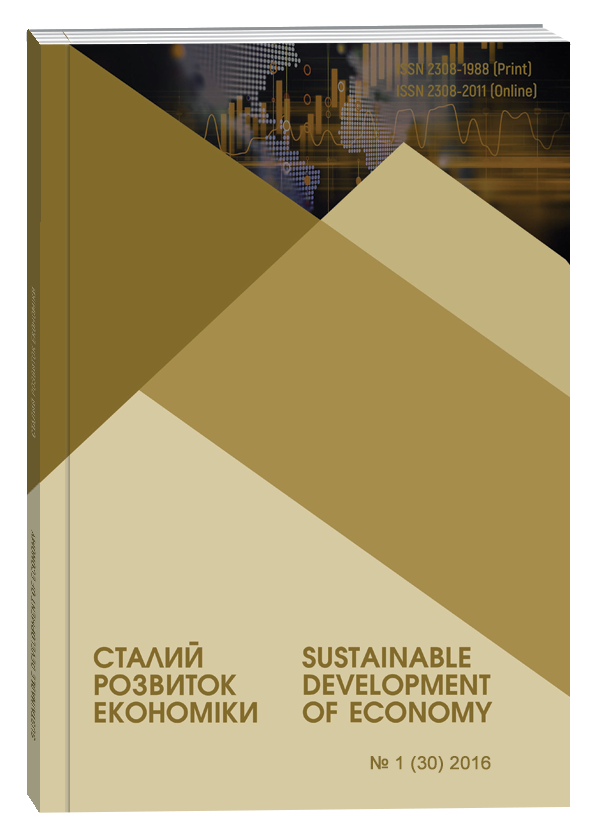THEORETICAL BASIS OF FORMATION OF MANAGEMENT SYSTEM THE COMPETITIVENESS OF ENTERPRISES
Abstract
Purpose. The aim of the article is the systematic study and theoretical substantiation of the content of the category “competitiveness” on the basis of formation of management system by this category. Methodology of the study. The principles of the economic theory, scientific works of domestic and foreign scientists on the issues of ensuring the competitiveness of enterprises are the theoretical and methodological basis of research. The following methods were used in the article: dialectical method of cognition – in the study of the transformation of competitive relations, substantiation of the concept of competitiveness management of entities; historical and logical – to identify the genesis and analyze of the evolution of competitiveness; theoretical generalization and comparison – for the development of conceptual apparatus, research of competitiveness at the macro and meso level; abstract and logical – at theoretical generalization of the nature and methods of formation mechanisms of competitiveness management of the industry; graphics – for visual displaying of the hierarchy of influence. Findings. The essence and content of the concept “competitiveness” has been disclosed. It has been substantiated that competitiveness is the ability of the national economy, industry, economic units to be ahead of the competitor in achieving raised economic objectives. The dominant inner factor of competitiveness is the competitiveness of products. It has been proven the competitiveness of products and the competitiveness of the enterprise is different according to the essence of the notion that harmoniously complements each other. The approaches regarding the inclusion of the production (competitiveness) factors, which form the composition and structure of the internal potential of the enterprise, have been considered. Originality. The classification by levels of competition, which allows us to determine the competitiveness of goods and the enterprise, has been carried out. The main approaches that reflect different aspects of competitiveness evaluation have been highlighted. Practical value. The obtained scientific statements and results of research are the basis for solving practical problems for competitive development of enterprises.
References
Пилчер Терри. Бенчмаркинг как средство повышения конкурентоспособности предприятий / Терри Пилчер // Европейское качество. Дайджест. – 2004. – №1. – С.40-45.
Пилчер Терри. Реальность и мифы: факторы, влияющие на производительность компаний / Терри Пилчер // Деловое совершенство. – 2006. – №5. – С.6-11.
Портер М. Международная конкуренция / М. Портер ; [пер. с англ. ; под ред. и с предисловием В. Д. Щетинина]. – М. : Международные отношения, 1993. – 896 с.
Пуцентейло П. Р. Конкурентоспроможність підприємства: методологія аналізу дефініції / П. Р. Пуцентейло // Інноваційна економіка. – 2015. – № 4. – С. 80-86.
Jeroen, C.J. Groot. Multi-objective optimization and design of farming systems / Jeroen C.J. Groot, Gerard J.M. Oomen and Walter A.H. Rossing // Agricultural Systems. – 2012. – Vol. 110. – Issue C, P. 63-77.
Kuosmanen, T. Weak disposability in nonparametric production analysis: reply to Färe and Grosskopf. / Kuosmanen, T. and Podinovski V. // American Journal of Agricultural. – 2008. – №91(2). – Р. 539-545.
Яців І.Б. Конкурентоспроможність сільськогосподарських підприємств : монографія / І.Б. Яців. – Львів : Український бестселер, 2013. – 427 с.
Niţă Dorina/ Approaching competitiveness at the level of multinational companies / Dorina Niţă, Codruța Dura // Annals of the University of Petroşani (Economics). – 2011. – 11(4). – P. 223-232.
Тарнавська Н. П. Управління конкурентоспроможністю підприємств: теорія, методологія, практика / Н. П. Тарнавська. – Тернопіль : Економічна думка, 2008. – 570 с.
Криворотов В.В. Методология формирования механизма управления конкурентоспособностью предприятия. / В.В. Криворотов. – Екатеринбург : УГТУ-УПИ, 2007. – 238 с.
Аристов О.В. Конкуренция и конкурентоспособность / О.В. Аристов. – М. : ЗАО “Финстатинформ”, 2009. – 347 с.
Pilcher, Terri (2004), “Benchmarking as a means of improving the competitiveness of enterprises”, Yevropeyskoye kachestvo. Daydzhest, no.1, pp.40-45.
Pilcher, Terri (2006), “Reality and Myths: factors affecting the performance of the companies”, Delovoye sovershenstvo, no. 5, pp. 6-11.
Porter, M. (1993), Mezhdunarodnaja konkurencija [International competition], Mezhdunarodnye otnoshenija, Moscow, Russia, 896 p.
Putsenteilo, P.R. (2015), “Competitiveness of the enterprise: methodology of the analysis of definition”, Innovatsiina ekonomika, no. 4, pp. 80-86.
Jeroen, C.J. Groot., Gerard, J.M. Oomen and Walter, A.H. Rossing, (2012), “Multi-objective optimization and design of farming systems”, Agricultural Systems, Vol. 110, Issue C, pp. 63-77.
Kuosmanen, T. and Podinovski, V. (2008), “Weak disposability in nonparametric production analysis: reply to Färe and Grosskopf”, American Journal of Agricultural, no. 91(2), pp. 539-545.
Yatsiv, I.B. (2013), Konkurentospromozhinst silskohospodarskykh pidpryiemstv [The competitiveness of agricultural enterprises], Ukrainskyi bestseler, Lviv, Ukraine, 427 p.
Niţă, Dorina and Codruța, Dura (2011), “Approaching competitiveness at the level of multinational companies”, Annals of the University of Petroşani (Economics), no. 11 (4), pp. 223-232.
Tarnavska, N.P. (2008), Upravlinnia konkurentospromozhnistiu pidpryiemstv: teoriia, metodolohiia, praktyka [Management of competitiveness of enterprises: the theory, methodology, practice], Ekonomichna dumka, Ternopil, Ukraine, 570 p.
Krivorotov, V.V (2007), Metodologiya formirovaniya mekhanizma upravleniya konkurentosposobnostyu predpriyatiya [Methodology of formation of competitiveness of the enterprise management mechanism], UGTU-UPI, Yekaterinburg, Russia, 238 p.
Aristov, O.V. (2009), Konkurentsiya i konkurentosposobnost [Competition and competitiveness], ZAO “Finstatinform”, Moscow, Russia, 347 p.


